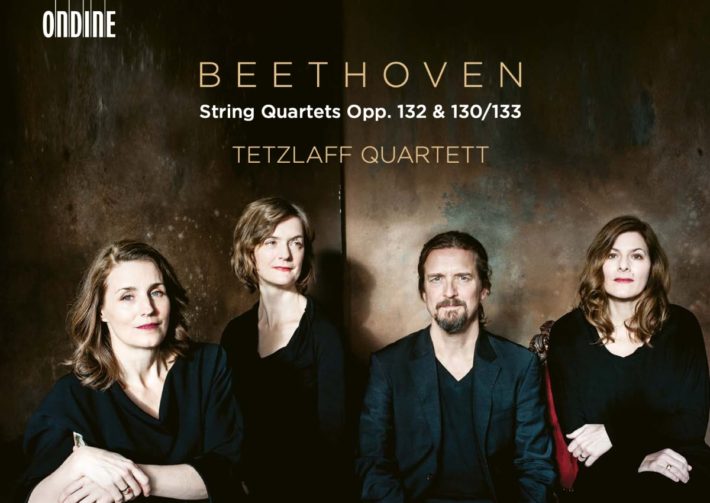On this album, the Tetzlaff quartet takes on two of Beethoven’s late string quartets, number 13 in Bb major and number 15 in A minor. These pieces run deep with emotion and contradiction, and are often said to represent the composer’s inner turmoil and illness. The Tetzlaff players provide a cooler, smoother interpretation than many other quartets — the word that often came to mind was “stone”. That isn’t to say their playing lacks emotion; it’s just sculptural, rather than organic. Their approach generates nuance.
The A minor quartet’s opening eight bars announce the four-note motif that’s central to both quartets, two half-steps a fifth apart. Just in this opening, Tetzlaff’s directness is noticeable, their tempo steady and their playing quasi-motionless. Compare them with a previous, more hot-blooded recording by the Brodsky quartet (reviewed here), whose account is passionate and, at times, desperate. In the Brodsky’s first eight bars, there is hesitation and distress, and constant motion in the sound. As the movement develops, the Brodsky group never settles down, the second theme still churning, the pianissimo moments still clinging to something. On the other hand, the Tetzlaff group finds a more relaxed color at the second theme, and in the pianissimo moments seems to relinquish control completely. This strategy allows the larger-scale shifts in the music to be noticed among the measure-to-measure chaos.
The second movement, a lilting tune in 3, sees the Tetzlaff group continue the structural approach. There is an emphasis on downbeats that almost turns the music into a waltz. The unison quarters that demarcate the sections are played without vibrato, so that the duets that emerge can blossom with just a hint of vibrato. Most striking is the “trio” section (track 2, 4’10”), which feels almost child-like in its simplicity, perhaps a reminiscence by one of the dancers from the first section. The Brodsky version may be more explicitly emotional, but they lose the character of the trio.
Related Classical Music Reviews
- Review: Beethoven – Late String Quartets – Brodsky Quartet
- Review: “Beethoven Around the World” – Quatuor Ébène
- Review: Beethoven And Sibelius Violin Concertos – Christian Tetzlaff
The Tetzlaff rendition does generate some heat in the third movement, the “holy song of thanksgiving” for which the quartet is nicknamed. First violin Christian Tetzlaff’s playing in the high registers is warm and controlled, with just the right amount of vibrato for shine and brilliance. After the amuse-bouche that is the fourth movement, the quartet’s finale seems to combine the best elements of the heat and cold of the previous movements. The main theme is undeniably Romantic in nature, and the group doesn’t let that go to waste. Fierce homophonic sections and detail-oriented playing work up quite a sweat, but all within an element of cool finesse. The Brodsky version often feels anchorless by comparison.
The Bb quartet that follows is more of a mixed bag. In the first movement, each mini-section is executed well, the moods present if slightly underutilized (marked by only a very subtle rubato within phrases), but because the music shifts so quickly, nothing is satisfying. This may well be the intention, but the Brodsky version seems to capture the same vacillation while also imbuing the music with life.
The three interior movements also lack a bit of character for my taste, especially the third movement, one of Beethoven’s rather apt and playful clock imitations. The Brodsky quartet really nails the “perpetuo moto” feeling while still finding a novel color or phrasing in almost every bar. Their tempo is deliciously unstable, their articulations seemingly infinitely varied. The Tetzlaff version feels a bit sterile and rushed in comparison, and they can’t find as many layers of texture.
The “Cavatina” and the “Grosse Fugue”, happily, are more effective. The “Cavatina” is still restrained, but the composition is introverted by nature, so it works quite well. Vibrato is again largely reserved for special moments, and a little sheen goes a long way. Ironically, I felt the “beklemmt” section (3’20”) was more airy than “oppressed”; still persuasive, though perhaps not how Beethoven intended it. Unlike the Brodsky Quartet, who included both the added Finale movement and the original “Grosse Fugue”, The Tetzlaff crew makes the choice for us, so to speak, and includes only the original Fugue, dropping the lovely sixth movement Allegro. In the Fugue, the Tetzlaff group achieves their most raucous and unrestrained playing of the album, but there’s still an incredible unity of ensemble. The grotesque harmonies are sung clearly, and there is a weightlessness to the frenzy. Again sticking to structure, each component of the fugue is homogenous in mood, with the overarching meaning coming from their interaction. The first meno mosso is stagnant, the second rich and sappy; the first 6/8 is angled and harsh, the second (which doubles as the coda) finally gentle and reassuring.
This album certainly presents ideas worth hearing and considering, and it’s a welcome addition to the Tetzlaff group’s output. The recording quality is top-notch, with the right balance of individual detail and group resonance. Recommended for anyone to expand their horizons, and equally for Beethoven followers.

Beethoven – String Quartet No. 13, Op. 130, No. 15, Op. 132
Tetzlaff Quartet:
Christian Tetzlaff – Violin
Elisabeth Kufferath – Violin
Hanna Weinmeister – Viola
Tanja Tetzlaff – Cello
Ondine, CD ODE 1347-2D
Recommended Comparisons
Read more classical music reviews or visit The Classic Review Amazon store
Follow Us and Comment:
Get our periodic classical music newsletter with our recent reviews, news and beginners guides.
We respect your privacy.









